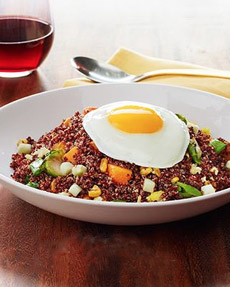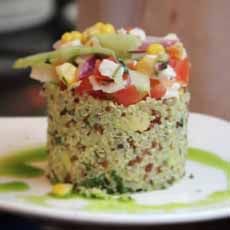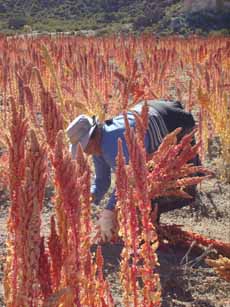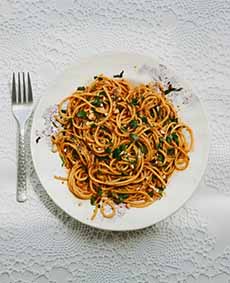TIP OF THE DAY: Quinoa, A Complete Protein, & Quinoa Pasta
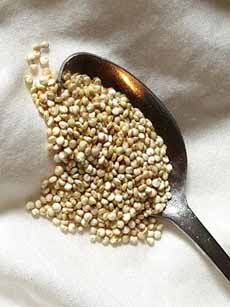 [1] White quinoa seeds (photo Methyl Soy | Wikipedia).
|
For more than five years, quinoa (pronounced KEEN-wah) has been an “it” food in the U.S. It has been embraced by those seeking more healthful alternatives. It’s a complete protein, meaning it contains all the essential amino acids (more about that below). Quinoa is thought of as a grain, but it is neither grain nor cereal but a pseudocereal. Rather, it is a type of seed. It’s gluten free and is often used in place of rice or couscous. Cereals (barley, corn, rice, wheat, etc.) are grasses. A pseudocereal is not a grass, but is used in much the same way. The seeds can be ground into flour or otherwise used as cereals. Other examples of pseudocereals are amaranth and buckwheat. High in protein, nutrients and vitamins, pseudocereals are typically gluten free and analogous to whole grains, even though they aren’t related. They are members of the spinach, chard and beet family. National Quinoa Day is January 16th, and National Whole Grains Day is November 16th. > The year’s 35+ grain holidays. > How about some quinoa pasta (below)? > Check out the recipes, also below. Quinoa is native to the Andes mountain region of South America. It is harvested from a species of a plant called goosefoot (here’s more about goosefoot), and is grown commercially for its nutritious seeds. Quinoa has been farmed for thousands of years and was an important food in the Andes. The ancient Incas called quinoa the “mother grain” and saw it as a sacred seed. Traditions paid tribute to its nutrition and other benefits. The first quinoa seed of each year was planted with a golden shovel by the Inca leader [source]. In Chile, Bolivia and Peru, quinoa is a very popular food and used in a wide variety of recipes including soup, bread, and, even, drinks. They can be combined with grains in any number of ways. Chefs have welcomed the gluten-free grain, turning it into vegetarian burgers, puddings, salads and recipes foods from simple to elegant (see the tabbouleh in photo #3). They’ve added quinoa to chocolate bars, truffles, and turned it into snack puffs, snack clusters and other foods. And, they have turned quinoa flour into pasta (more below). Other parts of the plant are also used. The leaves are eaten as a vegetable. (Ironically, world demand for quinoa has raised the price so much that the native farmers can’t afford to eat the seeds they grow, and are left with the perishable parts of the plant.) In many areas around the growing regions, the fruit of the quinoa plant is used as a topical medicine for cuts, sores, and bruises. Look for it near the rice section in grocery stores, or head to a natural foods store. You can find it in: Because it is a complete protein and can be grown worldwide, the U.N. declared 2013 the International Year of Quinoa. Why is a complete protein so important. The term “complete protein” refers to essential amino acids. Amino acids are the building blocks of protein. There are 20 different amino acids that can form a protein. Of these, there are nine* that the body can’t produce on its own. These are called essential amino acids: We need to eat them because our bodies can’t make them. In order to be considered complete, a food must contain all nine of these essential amino acids, in roughly equal amounts. According to Greatlist, in addition to quinoa, complete proteins include: Eggs, meat, milk and other foods deemed to be high in protein don’t come close to complete protein status. |
|
|
QUINOA PASTA If your year’s resolutions include cutting back on empty carbs like pasta, or eating more gluten-free foods, try quinoa pasta. It’s also egg-free.† The pasta has the same earthy quality as cooked quinoa seeds. *The nine essential amino acids are ” rel=”noopener” target=”_blank”>histidine, isoleucine, leucine, lysine, methionine, phenylalanine, threonine, tryptophan and valine. †While fresh pasta dough is made from a from flour, water, salt and eggs, dry pasta usually omits the egg. When eggs are added, it is called egg pasta or egg noodles. CHECK OUT WHAT’S HAPPENING ON OUR HOME PAGE, THENIBBLE.COM. |
||
